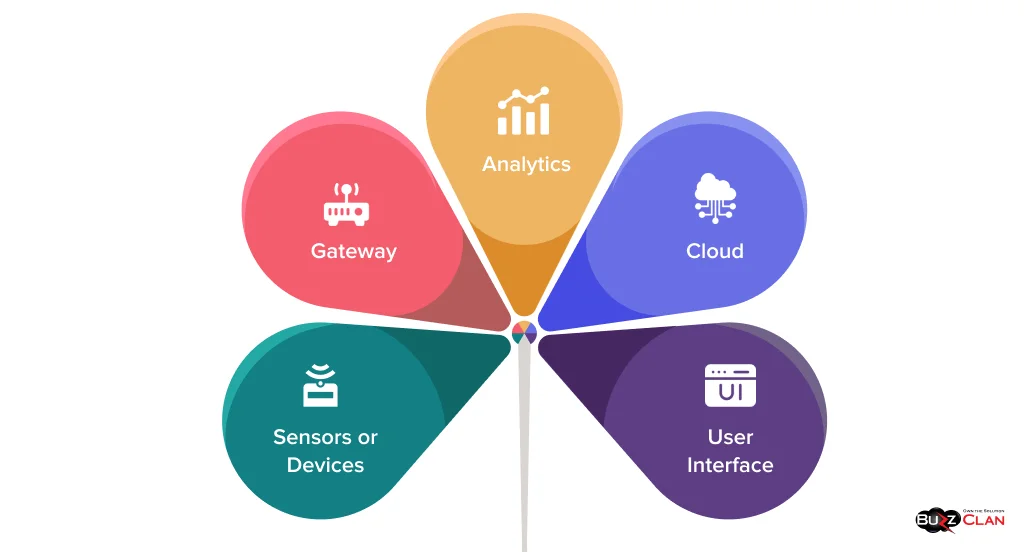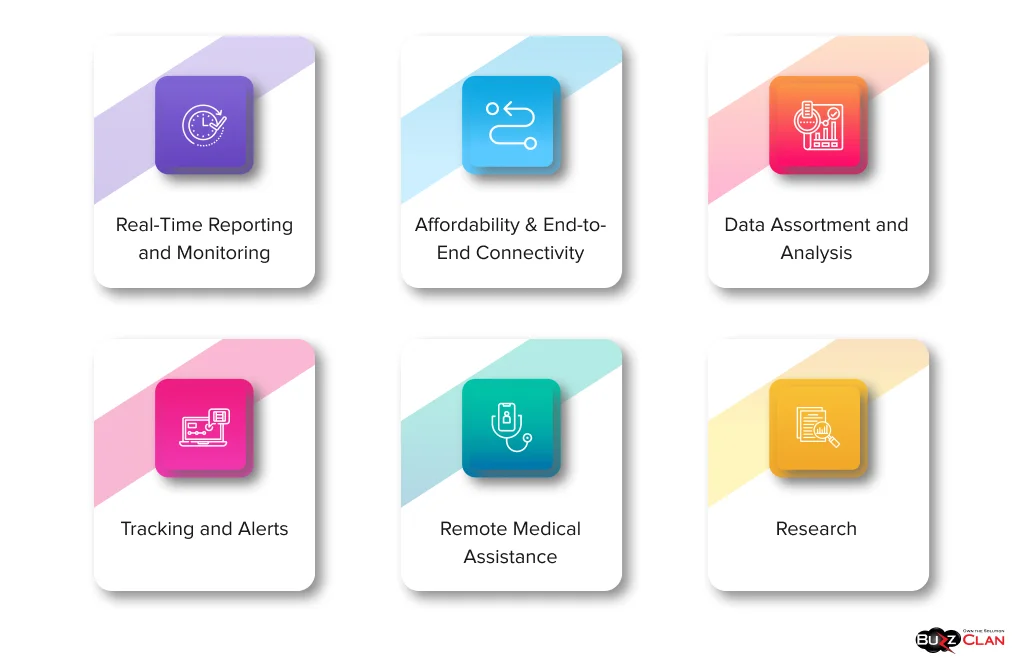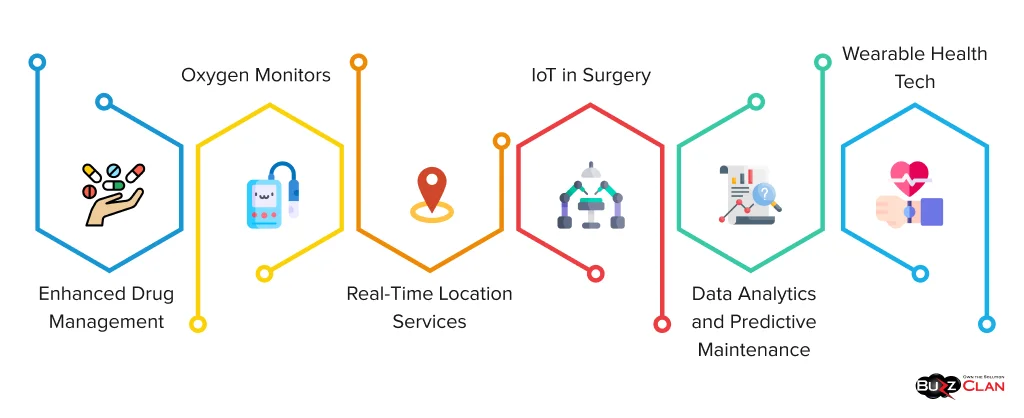How IoT in Healthcare is Streamlining Medical Processes?
Anjali Agrawal
Nov 20, 2024
The global Internet of Things (IoT) market in healthcare was valued at USD 139.74 billion in 2023. However, is a figure in billions worth a conversation? The answer is a bold “Yes.”
With IoT, you can expect real-time and remote monitoring facilities. This means you no longer need to wait for appointments and bow down to geographical boundaries.
While IoT devices have been designed to aid remote monitoring, they have the massive potential to improve the quality of patient care. So, what is the major roadblock to the technology? The answer is- Medical non-adherence.
When patients don’t consume medicines as prescribed, it can lead to severe health and poor health. Can IoT solve all these issues to emerge as a winner? This blog will discuss all the key factors and analyze the future.
Understanding IoT in Healthcare
Medication non-adherence is a common cause of concern for healthcare systems. Shockingly, 125,000 deaths in the U.S. could have been prevented if medical adherence was ensured. Luckily, IoT can be a knight in shining armor that offers all-round protection. Allow us to explain.
IoT in healthcare means seamless:
- Remote patient monitoring
- Automated communications
- Lower death rates
- Fewer ER visits
- Telehealth
- Smart medication dispensers
- Lower costs for patients and providers
All these factors contribute to lower cases of medical non-adherence. With easy communication, patients will no longer be confused about medicine doses. The elderly or even professionals may stay alone and have no active caregiver. In such cases, they may forget to take their dosages and falter on the given advice. Moreover, with fewer visits to the doctor, they can use the time saved to recuperate and cut costs spent on traveling and visitation fees.
Key Components of IoT in Healthcare

Now that you know how IoT can be a strong ally to the healthcare system, let’s understand how it functions.
Sensors or Devices
Sensors are instruments that collect and transmit data and take action based on that data. For example, Sensors measure temperature and humidity. The types of sensors include:
- Temperature Sensors
- Light Sensors
- Pressure Sensors
- Gas Sensors
- GPS Sensors
- Humidity Sensors
- Proximity Sensors
- Motion Sensors
Gateway
You can consider gateways as mediators between sensors and the central cloud. They help streamline communication, manage data, and process insights. Some of the critical functions of gateways include:
- Data Aggregation
- Load Balancing
- Latency Reduction
- Communication
- Security
- Protocol Translation
Cloud
The cloud in IoT manages data storage, collection, connectivity, integration, and cost efficiency.
Analytics
In this component, insights generated by IoT devices and sensors are analyzed. The core functions include:
- Data Processing
- Machine Learning
- Statistical Analysis
User Interface
User Interface is a medium through which users can interact with applications and systems. The main functions include:
- Data Visualization
- User-Friendly Design
- Personalization
- Remote Management
- Integration
- Authentication
Now that we know the main components of IoT in healthcare, let’s see how a device works.
- A sensor collects patient data and feeds it into the system
- AI-driven algorithms analyze the collected data
- The device then takes action on the information or sends it to the cloud
- Doctors can then make decisions based on the data provided by IoT healthcare solutions.
Benefits of Using IoT Devices in Healthcare

Here are a few advantages of using IoT devices in healthcare.
Real-Time Reporting and Monitoring
Reports suggest that the projected growth of Global RPM (Remote Patient Monitoring) is set to hit $175.2 billion by 2027. Remote health monitoring can save lives in case of medical emergencies like diabetes, heart failure, and asthma attacks. IoT devices in healthcare can easily be connected to smartphone apps, connect the required health data, and transfer the same to a cloud platform. Furthermore, the Centre of Connected Health Policy studied that a 50% reduction was witnessed in 30-day readmission rates because of remote patient monitoring of heart failure patients. IoT devices can collect and transfer data such as:
- Blood Pressure
- Oxygen
- Sugar Levels
- Weight
- ECG
The data can be stored in the cloud and shared with physicians, insurance companies, or external consultants for easy analysis.
End-to-End Connectivity and Affordability
IoT solutions can easily automate patient care workflows with mobility solutions and other technologies. IoT in healthcare paves the way for AI, machine-to-machine communication, and interoperability, making healthcare service delivery super effective.
Connectivity protocols can detect illnesses and devise innovative treatment methods. Technology-driven setups can also reduce healthcare costs in the long run by optimizing resource allocation and improving planning.
Data Assortment and Analysis
The vast amount of data a healthcare device sends quickly can be hard to store and manage if cloud access is unavailable. Acquiring data from multiple sources and performing manual analysis is also challenging. IoT devices can collect, report, and analyze real-time information, eliminating the need to store raw data. Cloud computing makes this possible. Healthcare operations can also allow organizations to access important health data, which can be used to gain insights and boost decision-making.
Tracking and Alerts
Real-time alerts play an essential role in managing chronic conditions. IoT devices in healthcare can gather data at the drop of a hat and transfer it to doctors for real-time tracking. Moreover, all the important people in the system are notified via mobile apps and smart sensors. Timely reports and alerts help make the right decisions regardless of place and time. Furthermore, it enables accurate tracking, monitoring, alerting, hands-on treatment, and patient care delivery results.
Remote Medical Assistance
An emergency can arise at any time. Luckily, patients can contact doctors sitting miles away with mobile apps. With enhanced mobility, doctors can check patients and identify ailments. Moreover, IoT-based healthcare delivery chains are building machines that can distribute drugs based on patent prescriptions and available ailment-related data. A significant advantage of this is reduced healthcare costs.
Research
IoT healthcare applications are also ideal for research purposes. These devices can collect data on patients’ illnesses, which would take decades to collect manually. Thus, the collected data can be used for statistical analysis and support medical research. These documents will further save time and money and enable the introduction of bigger and better medical treatments. Lastly, existing devices are now being updated by IoT by embedding chips in smart hospital devices. These chips enhance the assistance and care required by patients.
Are you looking forward to developing top-notch IoT applications? Fret not! We will customize solutions as per your requirements. Learn more about our services here.
How IoT in Healthcare is Improving Diagnostic Accuracy?

Let’s understand how IoT in healthcare is improving diagnostic accuracy.
Enhanced Drug Management
Smart pillboxes and IoT-enabled medication can revolutionize how patients manage their medication regimes, boosting medical adherence and treatment effectiveness. Such devices have alarms and notifications and can easily communicate with smartphones and other digital platforms, keeping patients on track with their medication and dosages. Furthermore, this can minimize the risk of hospitalizations due to medication errors.
Oxygen Monitors
IoT-enabled oxygen monitors provide immediate, real-time monitoring of oxygen levels. These advanced devices enable healthcare providers to make timely decisions and adjust treatment protocols, ensuring the best possible care for patients. Also, having continuous insights prevents emergencies such as severe hypoxia for patients with heart issues, respiratory conditions, or those recovering from surgery.
IoT in Surgery
IoT devices play a huge role in surgical environments. They enhance precision via telesurgery, image-guided surgery, and comprehensive patient monitoring. Moreover, IoT-enabled devices provide surgeons with real-time and high-resolution images, critical for complex surgeries and customized healthcare approaches.
Furthermore, telesurgery allows expert surgeons to operate remotely with robotic systems and provide specialized surgical care in underserved areas. Integrating IoT tools elevates the precision of surgical interventions, makes surgeries targeted, and boosts patient safety and outcomes.
Real-Time Location Services
Using IoT devices in healthcare is beneficial for tracking medical equipment, staff, and patients. They can not only boost operational efficiency but also make asset management seamless. By embedding sensors and utilizing RFID tags, hospitals can monitor the real-time location of equipment and ensure optimal use.
Additionally, tracking systems for staff and patients improve safety and workflow, allowing quicker emergency response times and personalized patient treatment. Precision in resource allocation can also reduce costs associated with misplaced or underutilized equipment, fostering a productive and effective healthcare environment.
Wearable Health Tech
About 80% of users share device-generated data with doctors to enhance health benefits and achieve their fitness goals. Wearables include smartwatches, special medical devices, and fitness trackers. These devices can track activity levels, heart rates, and sleep patterns. When doctors monitor these data sets, they can better diagnose health issues, take preventive measures, and devise personalized care strategies.
Data Analytics and Predictive Maintenance
Using IoT-based data for predictive analytics has the potential to innovate the way healthcare firms manage medical devices and equipment. By analyzing patterns and trends from historical data, equipment lifecycle and efficiency can be increased. The proactive approach ensures minimal downtime, optimizes resource allocation, and reduces emergency repair costs. Moreover, it can boost operational efficiency and pave the way for higher standards of patient care.
Read this case study to learn more about IoT data integration analytics
IoT Vulnerabilities in Healthcare
Not all that glitters is gold. Some key challenges to address for IoT in healthcare include:
Lack of Standardization
During their deployment, IoT devices are connected to multiple devices. These include drug delivery systems, equipment trackers, heart monitors, routers, and other connectors to complete the infrastructure.
However, connecting these means navigating multiple standards, languages, and protocols. This can lead to ambiguity around data ownership and regulations. Thus, integrating various devices through IoT becomes a significant challenge, and healthcare users need help aggregating data.
To solve this issue, universally accepted protocols must be developed for seamless interoperability between medical devices. Standards will smooth processes, reduce data collection costs, and minimize protocol gaps.
Security and Privacy Concerns
Guaranteeing patient safety is a must. However, devices that interact in real-time are prone to hacks and can risk data security. Most IoT devices lack end-to-end secure connections and adherence to data security protocols and standards.
Moreover, ambiguity around regulations makes data more susceptible to criminals. If not addressed, cybercriminals can steal sensitive health information, and as the devices evolve, companies will not be on the same page, leading to huge losses.
82% of healthcare organizations have reported attacks on IoT devices. The data transferred has been misused for fraudulent health claims and purchasing/buying drugs. The need of the hour is to build secure IoT hardware and software.
Integration with Legacy Systems
Integrating multiple devices brings its fair share of challenges. The same is true for IoT in healthcare. Manufacturers are yet to establish integration standards. Since the devices are constructed in isolation and within a defined ecosystem, they must be adept at working with other healthcare systems and applications.
This is why top medical device integration companies still need to achieve seamless integration between IoT-enabled devices. The key is to bring uniformity across devices that broadens the scope of integration.
Limited Bandwidth and Connectivity
More connectivity is needed for data exchange. Limited connectivity is the primary concern when connecting devices in IoT. While most medical IoT devices can be connected via WiFi, their cellular capabilities could be better. Limitations in connectivity can also increase costs when the number of devices increases. The high stakes for dropped connections can lead to devastating consequences in healthcare. Thus, low latency must be addressed.
High Implementation Costs
Costs are an area of concern when implementing any piece of technology. When healthcare providers adopt IoT, they increase charges for healthcare services. However, the surging costs can become a menace for customers and give rise to “Medical Tourism.” In such scenarios, people travel away from costly areas to access healthcare at minimal costs.
Lack of Skilled Professionals
A skilled and trained team of developers can easily tackle IoT challenges. However, poor staffing and inadequately trained IT departments are the norm. Thus, they need to handle a large influx of devices during implementation. Another issue is that only some trained teams can handle pre-existing IT operations, such as ensuring data backups, while others can take care of implementation. As a result, when large-scale deployment is done, the workload increases, and managing end-to-end security becomes a challenge.
Real-World Examples of IoT in Healthcare
IoT in healthcare is about making lives easier and transforming how patients perceive medical facilities. Here is a list of companies making it big in the IoT healthcare segment.
Hearables
Doppler Labs designed hearing aids that have helped hearing loss survivors interact better with the outside world. They sync easily with smartphones and even support adding layered features to real-world sounds.
Ingestible Sensors
These sensors are no less than magic. They can easily warn us of irregularities in our bodies and help us take remedial actions faster. One such example is Proteus Digital Health’s sensor. Those looking to manage their diabetes in an organized manner must try the same.
Moodables
Moodables can lift your mood in the right manner. They send low-intensity- currents to your brain and keep your mood light throughout the day. Companies that have significantly progressed in developing these devices include Thync and Halo Neurosciences.
Computer Vision Technology
The combination of AI and computer vision technology is disruptive. Visually impaired people can leverage it to mimic visual perception and make subsequent decisions. Drones like Skydio use computer vision technology to detect obstacles and make seamless navigation decisions.
Healthcare Charting
Patient charting can become a menace with manual methods. However, devices like Audemix can reduce the same as they capture voice commands and automate record keeping. Not only can you review patient data with ease, but you can also schedule the charting time with ease.
Smart Video Pills
Smart video pills travel through intestinal tracts to capture crystal-clear pictures. Once captured, the pictures can be sent to wearable devices to visualize the gastrointestinal tract and colon remotely.
Lifeline (formerly Philips Lifeline)
A boon for senior citizens, Lifeline is a personal emergency response system that facilitates independent living while providing 24/7 access to help. It is ideal for adults who reside in different cities/countries due to professional commitments.
ResMed
Another IoT device in healthcare on our list is AirSense 10 AutoSet (a product by ResMed). It offers remote monitoring capabilities, tracks sleep data, and receives personalized feedback from healthcare providers. This allows you to identify potential issues before they become serious.
Conclusion
The impact of IoT in healthcare has been significant, and the future holds immense potential. Here is what you can expect.
Here are some IoT future predictions in healthcare:
- Personalized healthcare: IoT devices will allow real-time patient data collection, which can be used to create tailored treatment plans for individual patients. This, in turn, will lead to effective treatment outcomes for patients.
- Remote patient monitoring: IoT devices in healthcare will allow healthcare providers to track conditions and take remedial actions as necessary, leading to fewer hospital visits and readmissions and significantly reducing healthcare costs.
- Predictive maintenance: IoT devices in healthcare will predict equipment failures and maintenance needs. As a result, hospitals and clinicians could provide uninterrupted care to patients.
- Telemedicine: Telemedicine services will enable patients to consult doctors remotely. This will be useful for patients who live in remote areas or have mobility issues.
FAQs

Get In Touch
